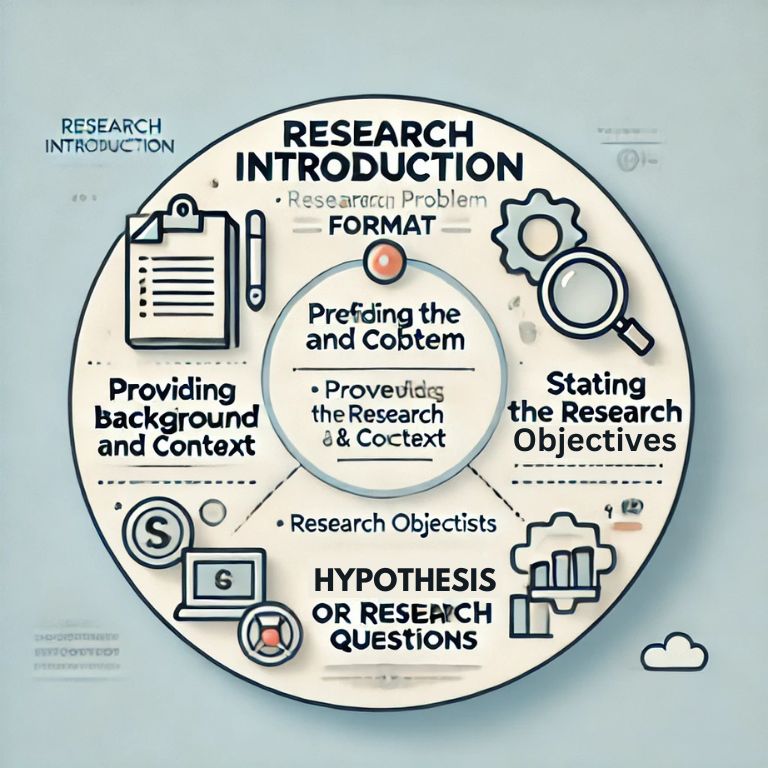Introduction
The research introduction format is a crucial aspect of any academic paper. It sets the stage for the entire research by establishing the topic, scope, and objectives. Whether you’re working on a qualitative or quantitative study, the introduction must grab the reader’s attention, provide background information, and define the research problem. Many researchers struggle with writing an engaging and effective introduction, especially when adhering to specific formats like APA or MLA. Luckily, tools like MyWordAi.com can streamline this process, making research writing easy for everyone. Download the app here to get started.

Key Elements of a Research Introduction
Writing a solid research introduction requires including key components that lay a foundation for the paper.
1. Defining the Research Problem
The introduction should clearly state the research problem or question you aim to address. This helps set the scope of your study and informs the reader about the significance of the research.
2. Providing Background and Context
Next, the introduction should provide enough background information to help readers understand the context of the study. This might include a literature review or previous research on the topic.
3. Stating the Research Objectives
The introduction must include the research objectives, which clarify what the study seeks to achieve. These objectives guide the structure of the paper and give readers a preview of your research goals.
4. Hypotheses or Research Questions
In more scientific studies, it’s important to include hypotheses or key research questions. These will direct the methodology and analysis sections of the paper.
Examples of Research Introduction Formats
There are several formats for writing a research introduction, depending on the type of research and the academic discipline.
1. APA Format Research Introduction Example
The APA format is commonly used in social sciences. The introduction starts with a general overview, narrows down to the specific research problem, and ends with the thesis statement or research question.
2. MLA Format Research Introduction Example
MLA format, primarily used in the humanities, often begins with a hook to engage the reader, followed by background information and the thesis statement.
3. Qualitative and Quantitative Research Introduction Formats
- In qualitative research, the introduction focuses on exploring a social or cultural phenomenon, with an emphasis on context and subjectivity.
- For quantitative studies, the introduction often highlights measurable variables and hypotheses.
Writing a Research Proposal Introduction
Writing an effective introduction for a research proposal requires a clear structure.
1. What is the Format of a Research Proposal?
A research proposal introduction must outline the research problem, objectives, and significance of the study.
2. Example of a Research Proposal Introduction
For example, an introduction might start by identifying the gap in the current research and explaining how the proposed study will fill that gap.
3. How to Write an Introduction for a Research Proposal PDF
When preparing a research proposal PDF, ensure the introduction is concise, clearly stating your research focus while adhering to the guidelines of your academic institution.
Step-by-Step Guide: Writing a Research Introduction Using IMRAD Format
The IMRAD format (Introduction, Methods, Results, and Discussion) is a common structure for research papers.
1. Introduction in Research Following IMRAD Format
In the IMRAD format, the introduction provides the rationale for the study, a review of relevant literature, and the research problem. It should explain why the research is important and set the stage for the methods section.
2. Tips for Writing an APA Style Research Introduction
- Use clear, concise language.
- Begin with a broad statement of the topic, then narrow down to your specific research problem.
- End with your research objectives or hypothesis.
Sample Introduction Research Paper (APA Style)
Below is a sample introduction for an APA-style research paper:
“The relationship between social media usage and mental health has been a subject of growing interest. Previous studies suggest that heavy social media users are at a greater risk of anxiety and depression. However, there is limited research on the impact of social media on college students’ mental well-being. This study aims to explore the effects of social media on the mental health of undergraduate students in the United States, with a focus on anxiety and depression.”
How MyWordAi.com Can Help You Write a Research Introduction
MyWordAi.com is an automated academic writing tool powered by ChatGPT that helps researchers write their papers efficiently. The tool is pre-prompted with academic guidelines, eliminating the need to learn AI prompting or research paper formatting.
1. Introduction to MyWordAi as an Automated Academic Writer
By using MyWordAi.com, researchers can quickly generate well-structured introductions for their papers. The app integrates APA and MLA formatting rules, ensuring that your introduction adheres to academic standards.
2. Step-by-Step Guide to Using MyWordAi for Research
- Download the MyWordAi app here.
- Open the app and choose the “Complete Research Writer” then click on “Introduction” template.
- Enter your research topic, research questions, and click generate.
- MyWordAi will generate a well-organized introduction based on APA or MLA style, which you can refine as needed.
- You can also use the app to format the entire paper, from introduction to conclusion.
Conclusion
Using MyWordAi.com can simplify the process of writing research papers by automating academic writing tasks. Whether you’re working on a proposal or a full-length paper, MyWordAi provides the tools to produce polished and formatted content quickly. Download the app here and start writing smarter today.
Make your research writing easy and hassle-free with MyWordAi.com. Visit the Playstore and download the app now: MyWordAi App.